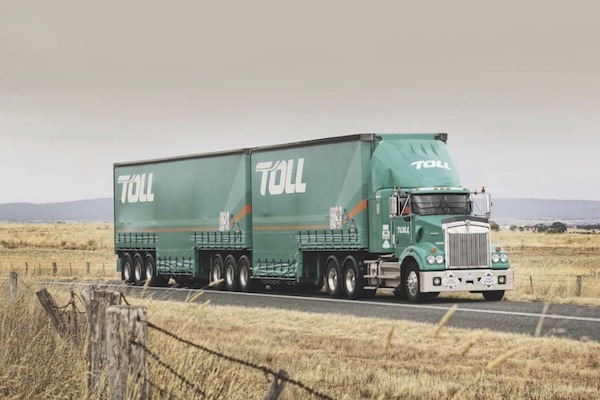Published on the 05/10/2023 | Written by Heather Wright

40 percent reduction in cost and halving of project times…
When Stuart Robertson, head of digital technologies at Toll Group, talks about his work spearheading the use of low code application development withint the global logistics provider, he’s clear it’s not just another IT project.
“What we are doing is changing how the organisation looks at itself.
“The most important thing around the platforms is the focus. At the end of the day, it’s not about the technology. What we want to solve and to enable for Toll is new products and services. We want to uplift our employees and be able to effectively move quicker.”
“It is about how we enable new capability and innovation that enables us to differentiate ourselves.”
Robertson has been with Toll, whose global forwarding takes in 28 countries and around 500 sites, for six years. The first three years were focused on traditional, high-code development. That included the development of MyToll.com, a B2B2C customer portal, developed by a team of around 30.
With the 20212 sale of Toll’s Global Express business, Robertson says Toll ‘transitioned that asset out’, and he began building a centre of excellence around automation, analytics, data science, AI and low code.
“The real power comes when we start bringing those platforms and technologies together to solve business problems,” Robertson says.
The company has moved a number of its legacy platforms, which covered a range of technologies and languages, towards retirement thanks to its adoption of low-code, using the Mendix platform.
It’s already seen a 40 percent reduction in cost to deliver projects, and projects that were taking 12 or 24 weeks are now taking six or 12.
“You can solve problems with traditional development but we wanted to move away from traditional development because what I couldn’t do was effectively scale that traditional delivery model to cater to the breadth of Toll and all the use cases.
“We wanted to be able to build proprietary software and drive competitive advantage, but we wanted to be able to do that quickly and cost effectively.”
Robertson notes that the legacy systems and processes were also leading to inefficiencies and high costs.
But he’s clear: The move to low-code wasn’t about competing with SaaS and commercial off the shelf offerings such as warehouse management systems and transport management systems already in place. They’re available to anyone.
“For us it is about how we enable new capability and innovation that enables us to differentiate ourselves.
“Where we can differentiate and innovate and really digitise processes outside of that remit is in the low-code space. So we were looking at how do we take manual processes and digitise them.”
For Toll that’s everything from apps supporting drivers, to those used by the president or managing director.
Two years ago, it began assessing products available in Australia, ultimately selecting Mendix in a multimillion dollar deal.
It wasn’t just about engaging potential vendors though.
“We didn’t want it to be that IT had gone and bought another tool and were forcing everyone to use it, so we did a lot of engagement and took the business with us on this journey, having multiple sessions from the operations teams through to the presidents showing them the capability and what it actually translated to.”
It was being able to take use cases from divisions and, in a week, model an app to show to them that was a big winner.
“That’s where the penny dropped for the business, because they understood – we demonstrated building an app. It wasn’t production ready, but you could see it, click it, touch it.
“That was extremely helpful in making the case.”
He admits though, that when the deal was signed, Toll had ‘zero capability’ to do anything on the platform. No one had been hired who knew about the offering.
Toll wanted to provide federated delivery, enabling the development of applications as close to the business as possible, with Robertson keen to see divisional IT teams with capability to sit with the business, model and deliver applications.
“But that requires governance. It requires guardrails, and because we wanted to go down a really reusable architecture, we wanted to make sure people weren’t building and rebuilding the same components multiple times. So we wanted visibility on what was being done… and then governance around making decisions on what was reusable, what wasn’t, documenting those as key design decision sand making sure any unique patterns also go through the architecture and governance processes to make sure they are secure.”
While the platform is secure, it’s still easy to build application that aren’t secure, he notes.
“We have to make sure those applications are plumbed into Azure AD, but also then how do third parties access them?”
Building the reusuable components too longer and required plenty of work to be done, but meant there was less to be done for the next project.
“You have to have the foundations in place around the platform, including delivery capability.”
The first application developed was for the risk and audit business unit. Completed in less than six weeks and costing less than $30,000, the risk management and audit app is used by operations managers to document specific risks and the mitigations taken, with the information sent to GMs, executive GMs, presidents and MDs.
It was, he notes, a highly visible application to start with.
“It’s something we had never been able to do before and arguably couldn’t do using traditional software development because provisioning servers, getting developers, writing code, all the other bits that go into doing it – it’s not something we were engineered to do.”
Getting quick wins from the business was key.
A ‘pretty simple’ progressive web app on mobile devices, plumbed into the camera, was quickly developed for the Singapore automotive logistics division, which traditionally sent staff out with pen and paper to record vehicle VINs and damage as they came off the ships. It eliminated paperwork and increased efficiencies.
More recently, a new legal capital review application launched. Robertson’s team built a delegation of authority module for the app, which mirrors a lot of the organisation – a complicated issue when your business covers everyone from a person in the warehouse wanting to spend $20 on cleaning liquid, through to someone needing approval for a $200 million investment in a warehouse.
“It allows us to build an application really quickly, change how people work and demonstrate the product.”
Robertson says applications have been integrated into a number of Toll platforms, including the global transport systems, AD and Azure for data and PowerBI to show analytics in the platform itself. As yet, nothing has been integrated in SAP. (Earlier this year, Toll, which is a Sap S/4 Hana enviornment, became one of the first enterprise users of SAP’s sovereign cloud in Australia.)
Creating apps, however is of no use if no one uses it. Toll defined its value metrics early on as part of its operationalisation and user adoption is part of that. It has now connected Google Analytics into its application so it can see how people are using the applications.
“We are not quite there yet, but we want to get to data driven design with both employee and customer applications, where we can see how people are using the products and then evolve and enhance them.”
He admits engagement with the wider business is an ongoing process.
“This is about changing people and one of the big focuses is how do we create digital and data savvy people in Toll. A large side of my remit is helping evolve how we think and work. Part of that is how we organise around projects and initiatives.”
Robertson is blunt: Some of the early apps, created without a delivery function, did create technical debt. “We knew we would have to go back to them and we have gone back to update design on those applications. But they allowed us to demonstrate to the business that we could solve things for them quickly and prove you can do things quickly with the right construct – having the right product owner, the right delivery function.
“Sometimes you have to just get going.”



























